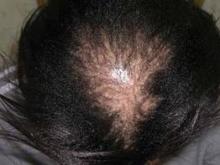NEW YORK – To successfully treat alopecia in darker-skinned patients, it is important to first get to the root of a patient’s hair care regimen, according to Dr. Amy McMichael.
For the past 18 years, Dr. McMichael of Wake Forest University in Winston-Salem, N.C., has run a hair disorders clinic. She said she often finds herself at odds with patients who can’t understand why their hair won’t grow.
"Of course, we know it’s growing; it’s just breaking off. They’re having issues with damaged hair," she said at the Skin of Color Seminar Series. Patients "want me to find some underlying vitamin disorder or disease, or something [in their diet] that they can ‘cut out,’ " she said.
Instead, the key is to specifically ask patients about their hair care regimen. She also uses a "60-second comb test" to assess fragility, whereby she instructs patients to brush their hair over a white pillow for 60 seconds and then count the broken and full-bulb hairs that are seen on the pillow.
More often than not, she said she finds that the number of full telogen hairs do not differ between white and darker-skinned people, but that broken hairs (versus bulb hairs) are found significantly more often in women of African descent.
This standardized approach may help convince women that, indeed, breakage – and not some underlying condition – is at the root of their problem, and that changes in behavior could have big effects.
Traction alopecia is a major issue in this population – even among patients who say they don’t pull their hair – and is likely because of the African American custom of getting tight braids starting at a young age. "They tell me their hair braids were so tight, they couldn’t chew the next day," she said. "That is not normal."
Additionally, many skin of color patients use powerful, lye-based chemical relaxers. The damage inflicted by these products, combined with braids, increases the risk for alopecia.
She pointed to a 2008 study of 574 African school girls and 604 African women that showed that females who both relaxed and braided their hair had a 3.5 times greater risk for traction alopecia, compared with patients who did neither (J. Am. Acad. Dermatol. 2008;59:432-8).
Central centrifugal scarring alopecia is also associated with particular cultural practices. For example, Dr. McMichael cited a 2009 study that looked at 101 black women with the condition and found that there was a strong association between scarring alopecia and patients who reported using sewn-in hair weaves and braided styles with hair extensions (J. Am. Acad. Dermatol. 2009;60:574-8).
A second 2011 study by Dr. McMichael and her colleagues confirmed this, but also found associations with chemical relaxers in 44 surveyed patients (Cosmet. Dermatol. 2011;24:331-7).
She recommends that patients discontinue tight braids, sewn-in weaves, relaxers, and heat treatments. "A lot of women still go under hooded hair dryers," she said. She also advocates serial trimming of the hair every 6-8 weeks, as well as gentle hair conditioning with positively charged silicones and dimethicone coating agents.
"These work very nicely in this population," she said. She also recommends using foams as a vehicle for treatments when available. For patients with more severe issues, however, she has administered intralesional corticosteroids, and followed with an off-label use of topical minoxidil.
Additionally, "a lot of women do well with surgical hair restoration," she said, despite initial patient concerns about it being prohibitively expensive. "It might be much less expensive [than patients think] because they have a small area to treat."
Finally, Dr. McMichael said she refers patients with cicatricial alopecia to the Cicatricial Alopecia Research Foundation.
Dr. McMichael stated that she has been an investigator for Abbott, Allergan, Intendis (now Bayer HealthCare), and Procter and Gamble. She also disclosed serving as a consultant for Allergan, Galderma, Guthy-Ranker, Johnson and Johnson, Procter and Gamble, and Stiefel.


